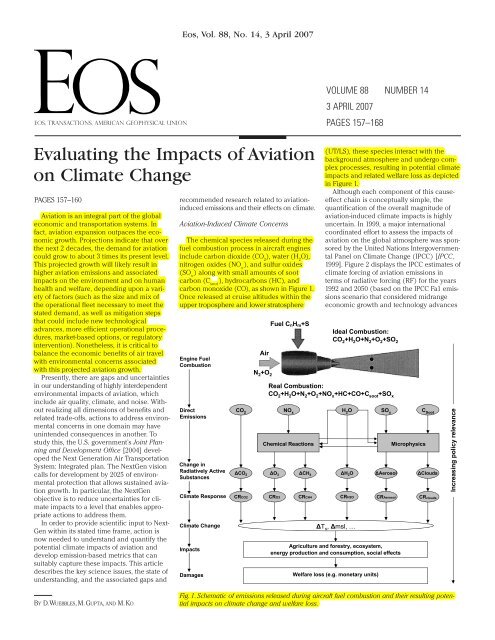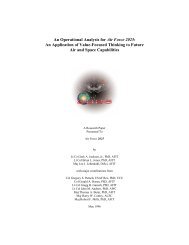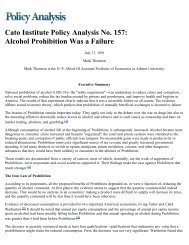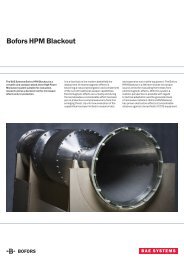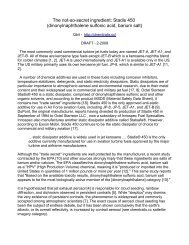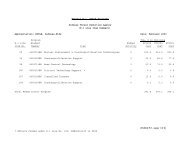Evaluating the Impacts of Aviation on Climate Change - Pa.op.dlr.de
Evaluating the Impacts of Aviation on Climate Change - Pa.op.dlr.de
Evaluating the Impacts of Aviation on Climate Change - Pa.op.dlr.de
Create successful ePaper yourself
Turn your PDF publications into a flip-book with our unique Google optimized e-Paper software.
Eos, Vol. 88, No. 14, 3 April 2007<br />
EOS, TRANSACTIONS, AMERICAN GEOPHYSICAL UNION<br />
<str<strong>on</strong>g>Evaluating</str<strong>on</strong>g> <str<strong>on</strong>g>the</str<strong>on</strong>g> <str<strong>on</strong>g>Impacts</str<strong>on</strong>g> <str<strong>on</strong>g>of</str<strong>on</strong>g> <str<strong>on</strong>g>Aviati<strong>on</strong></str<strong>on</strong>g><br />
<strong>on</strong> <strong>Climate</strong> <strong>Change</strong><br />
PAGES 157–160<br />
<str<strong>on</strong>g>Aviati<strong>on</strong></str<strong>on</strong>g> is an integral part <str<strong>on</strong>g>of</str<strong>on</strong>g> <str<strong>on</strong>g>the</str<strong>on</strong>g> global<br />
ec<strong>on</strong>omic and transportati<strong>on</strong> systems. In<br />
fact, aviati<strong>on</strong> expansi<strong>on</strong> outpaces <str<strong>on</strong>g>the</str<strong>on</strong>g> ec<strong>on</strong>omic<br />
growth. Projecti<strong>on</strong>s indicate that over<br />
<str<strong>on</strong>g>the</str<strong>on</strong>g> next 2 <strong>de</strong>ca<strong>de</strong>s, <str<strong>on</strong>g>the</str<strong>on</strong>g> <strong>de</strong>mand for aviati<strong>on</strong><br />
could grow to about 3 times its present level.<br />
This projected growth will likely result in<br />
higher aviati<strong>on</strong> emissi<strong>on</strong>s and associated<br />
impacts <strong>on</strong> <str<strong>on</strong>g>the</str<strong>on</strong>g> envir<strong>on</strong>ment and <strong>on</strong> human<br />
health and welfare, <strong>de</strong>pending up<strong>on</strong> a variety<br />
<str<strong>on</strong>g>of</str<strong>on</strong>g> factors (such as <str<strong>on</strong>g>the</str<strong>on</strong>g> size and mix <str<strong>on</strong>g>of</str<strong>on</strong>g><br />
<str<strong>on</strong>g>the</str<strong>on</strong>g> <strong>op</strong>erati<strong>on</strong>al fleet necessary to meet <str<strong>on</strong>g>the</str<strong>on</strong>g><br />
stated <strong>de</strong>mand, as well as mitigati<strong>on</strong> steps<br />
that could inclu<strong>de</strong> new technological<br />
advances, more efficient <strong>op</strong>erati<strong>on</strong>al procedures,<br />
market-based <strong>op</strong>ti<strong>on</strong>s, or regulatory<br />
interventi<strong>on</strong>). N<strong>on</strong>e<str<strong>on</strong>g>the</str<strong>on</strong>g>less, it is critical to<br />
balance <str<strong>on</strong>g>the</str<strong>on</strong>g> ec<strong>on</strong>omic benefits <str<strong>on</strong>g>of</str<strong>on</strong>g> air travel<br />
with envir<strong>on</strong>mental c<strong>on</strong>cerns associated<br />
with this projected aviati<strong>on</strong> growth.<br />
Presently, <str<strong>on</strong>g>the</str<strong>on</strong>g>re are gaps and uncertainties<br />
in our un<strong>de</strong>rstanding <str<strong>on</strong>g>of</str<strong>on</strong>g> highly inter<strong>de</strong>pen<strong>de</strong>nt<br />
envir<strong>on</strong>mental impacts <str<strong>on</strong>g>of</str<strong>on</strong>g> aviati<strong>on</strong>, which<br />
inclu<strong>de</strong> air quality, climate, and noise. Without<br />
realizing all dimensi<strong>on</strong>s <str<strong>on</strong>g>of</str<strong>on</strong>g> benefits and<br />
related tra<strong>de</strong>-<str<strong>on</strong>g>of</str<strong>on</strong>g>fs, acti<strong>on</strong>s to address envir<strong>on</strong>mental<br />
c<strong>on</strong>cerns in <strong>on</strong>e domain may have<br />
uninten<strong>de</strong>d c<strong>on</strong>sequences in ano<str<strong>on</strong>g>the</str<strong>on</strong>g>r. To<br />
study this, <str<strong>on</strong>g>the</str<strong>on</strong>g> U.S. government’s Joint Planning<br />
and Devel<strong>op</strong>ment Office [2004] <strong>de</strong>vel<strong>op</strong>ed<br />
<str<strong>on</strong>g>the</str<strong>on</strong>g> Next Generati<strong>on</strong> Air Transportati<strong>on</strong><br />
System: Integrated plan. The NextGen visi<strong>on</strong><br />
calls for <strong>de</strong>vel<strong>op</strong>ment by 2025 <str<strong>on</strong>g>of</str<strong>on</strong>g> envir<strong>on</strong>mental<br />
protecti<strong>on</strong> that allows sustained aviati<strong>on</strong><br />
growth. In particular, <str<strong>on</strong>g>the</str<strong>on</strong>g> NextGen<br />
objective is to reduce uncertainties for climate<br />
impacts to a level that enables appr<strong>op</strong>riate<br />
acti<strong>on</strong>s to address <str<strong>on</strong>g>the</str<strong>on</strong>g>m.<br />
In or<strong>de</strong>r to provi<strong>de</strong> scientific input to Next-<br />
Gen within its stated time frame, acti<strong>on</strong> is<br />
now nee<strong>de</strong>d to un<strong>de</strong>rstand and quantify <str<strong>on</strong>g>the</str<strong>on</strong>g><br />
potential climate impacts <str<strong>on</strong>g>of</str<strong>on</strong>g> aviati<strong>on</strong> and<br />
<strong>de</strong>vel<strong>op</strong> emissi<strong>on</strong>-based metrics that can<br />
suitably capture <str<strong>on</strong>g>the</str<strong>on</strong>g>se impacts. This article<br />
<strong>de</strong>scribes <str<strong>on</strong>g>the</str<strong>on</strong>g> key science issues, <str<strong>on</strong>g>the</str<strong>on</strong>g> state <str<strong>on</strong>g>of</str<strong>on</strong>g><br />
un<strong>de</strong>rstanding, and <str<strong>on</strong>g>the</str<strong>on</strong>g> associated gaps and<br />
recommen<strong>de</strong>d research related to aviati<strong>on</strong>induced<br />
emissi<strong>on</strong>s and <str<strong>on</strong>g>the</str<strong>on</strong>g>ir effects <strong>on</strong> climate.<br />
<str<strong>on</strong>g>Aviati<strong>on</strong></str<strong>on</strong>g>-Induced <strong>Climate</strong> C<strong>on</strong>cerns<br />
The chemical species released during <str<strong>on</strong>g>the</str<strong>on</strong>g><br />
fuel combusti<strong>on</strong> process in aircraft engines<br />
inclu<strong>de</strong> carb<strong>on</strong> dioxi<strong>de</strong> (CO 2<br />
), water (H 2<br />
O),<br />
nitrogen oxi<strong>de</strong>s (NO x<br />
), and sulfur oxi<strong>de</strong>s<br />
(SO x<br />
) al<strong>on</strong>g with small amounts <str<strong>on</strong>g>of</str<strong>on</strong>g> soot<br />
carb<strong>on</strong> (C soot<br />
), hydrocarb<strong>on</strong>s (HC), and<br />
carb<strong>on</strong> m<strong>on</strong>oxi<strong>de</strong> (CO), as shown in Figure 1.<br />
Once released at cruise altitu<strong>de</strong>s within <str<strong>on</strong>g>the</str<strong>on</strong>g><br />
upper tr<strong>op</strong>osphere and lower stratosphere<br />
VOLUME 88 NUMBER 14<br />
3 APRIL 2007<br />
PAGES 157–168<br />
(UT/LS), <str<strong>on</strong>g>the</str<strong>on</strong>g>se species interact with <str<strong>on</strong>g>the</str<strong>on</strong>g><br />
background atmosphere and un<strong>de</strong>rgo complex<br />
processes, resulting in potential climate<br />
impacts and related welfare loss as <strong>de</strong>picted<br />
in Figure 1.<br />
Although each comp<strong>on</strong>ent <str<strong>on</strong>g>of</str<strong>on</strong>g> this causeeffect<br />
chain is c<strong>on</strong>ceptually simple, <str<strong>on</strong>g>the</str<strong>on</strong>g><br />
quantificati<strong>on</strong> <str<strong>on</strong>g>of</str<strong>on</strong>g> <str<strong>on</strong>g>the</str<strong>on</strong>g> overall magnitu<strong>de</strong> <str<strong>on</strong>g>of</str<strong>on</strong>g><br />
aviati<strong>on</strong>-induced climate impacts is highly<br />
uncertain. In 1999, a major internati<strong>on</strong>al<br />
coordinated effort to assess <str<strong>on</strong>g>the</str<strong>on</strong>g> impacts <str<strong>on</strong>g>of</str<strong>on</strong>g><br />
aviati<strong>on</strong> <strong>on</strong> <str<strong>on</strong>g>the</str<strong>on</strong>g> global atmosphere was sp<strong>on</strong>sored<br />
by <str<strong>on</strong>g>the</str<strong>on</strong>g> United Nati<strong>on</strong>s Intergovernmental<br />
<strong>Pa</strong>nel <strong>on</strong> <strong>Climate</strong> <strong>Change</strong> (IPCC) [IPCC,<br />
1999]. Figure 2 displays <str<strong>on</strong>g>the</str<strong>on</strong>g> IPCC estimates <str<strong>on</strong>g>of</str<strong>on</strong>g><br />
climate forcing <str<strong>on</strong>g>of</str<strong>on</strong>g> aviati<strong>on</strong> emissi<strong>on</strong>s in<br />
terms <str<strong>on</strong>g>of</str<strong>on</strong>g> radiative forcing (RF) for <str<strong>on</strong>g>the</str<strong>on</strong>g> years<br />
1992 and 2050 (based <strong>on</strong> <str<strong>on</strong>g>the</str<strong>on</strong>g> IPCC Fa1 emissi<strong>on</strong>s<br />
scenario that c<strong>on</strong>si<strong>de</strong>red midrange<br />
ec<strong>on</strong>omic growth and technology advances<br />
BY D. WUEBBLES, M. GUPTA, AND M. KO<br />
Fig. 1. Schematic <str<strong>on</strong>g>of</str<strong>on</strong>g> emissi<strong>on</strong>s released during aircraft fuel combusti<strong>on</strong> and <str<strong>on</strong>g>the</str<strong>on</strong>g>ir resulting potential<br />
impacts <strong>on</strong> climate change and welfare loss.
Eos, Vol. 88, No. 14, 3 April 2007<br />
for both improved fuel efficiency and NO x<br />
reducti<strong>on</strong>).<br />
In 1992, aviati<strong>on</strong> c<strong>on</strong>tributed about 2% <str<strong>on</strong>g>of</str<strong>on</strong>g><br />
<str<strong>on</strong>g>the</str<strong>on</strong>g> total anthr<strong>op</strong>ogenic CO 2<br />
emissi<strong>on</strong>s and<br />
accounted for globally and annually averaged<br />
RF (GAARF) <str<strong>on</strong>g>of</str<strong>on</strong>g> about 0.02 watts per<br />
square meter. In c<strong>on</strong>trast, <str<strong>on</strong>g>the</str<strong>on</strong>g> GAARF for all<br />
n<strong>on</strong>-CO 2<br />
aviati<strong>on</strong> emissi<strong>on</strong>s combined<br />
(excluding cirrus clouds) is as large as that<br />
<str<strong>on</strong>g>of</str<strong>on</strong>g> CO 2<br />
al<strong>on</strong>e, though characterized by relatively<br />
large uncertainties. Figure 2 clearly<br />
indicates that <str<strong>on</strong>g>the</str<strong>on</strong>g> level <str<strong>on</strong>g>of</str<strong>on</strong>g> scientific un<strong>de</strong>rstanding<br />
to estimate climate resp<strong>on</strong>se due to<br />
n<strong>on</strong>-CO 2<br />
emissi<strong>on</strong>s for both cases ranges<br />
from fair to very poor.<br />
GAARF has wi<strong>de</strong>ly been used as a metric <str<strong>on</strong>g>of</str<strong>on</strong>g><br />
climate change for l<strong>on</strong>g-lived greenhouse<br />
gases. However, <str<strong>on</strong>g>the</str<strong>on</strong>g>re are c<strong>on</strong>tinued questi<strong>on</strong>s<br />
about its viability and usefulness for<br />
o<str<strong>on</strong>g>the</str<strong>on</strong>g>r greenhouse gases [Nati<strong>on</strong>al Aca<strong>de</strong>my<br />
<str<strong>on</strong>g>of</str<strong>on</strong>g> Sciences, 2005]. A fundamental issue is<br />
that some RFs (e.g., those from c<strong>on</strong>trails,<br />
induced cirrus clouds, and oz<strong>on</strong>e from NO x<br />
emissi<strong>on</strong>s) are spatially inhomogeneous and<br />
seas<strong>on</strong>ally varying. Therefore, RF from each<br />
<str<strong>on</strong>g>of</str<strong>on</strong>g> <str<strong>on</strong>g>the</str<strong>on</strong>g>se various sources could produce a different<br />
temperature change at <str<strong>on</strong>g>the</str<strong>on</strong>g> surface <str<strong>on</strong>g>of</str<strong>on</strong>g><br />
<str<strong>on</strong>g>the</str<strong>on</strong>g> Earth per unit change in GAARF. In additi<strong>on</strong>,<br />
values given in Figure 2 represent <str<strong>on</strong>g>the</str<strong>on</strong>g><br />
change in forcing from changes in c<strong>on</strong>centrati<strong>on</strong>s<br />
due to all prior aviati<strong>on</strong> activities.<br />
Since <str<strong>on</strong>g>the</str<strong>on</strong>g> atmospheric effects due to aviati<strong>on</strong><br />
emissi<strong>on</strong>s have very different timescales,<br />
ranging from several hundred years for CO 2<br />
to a few hours for c<strong>on</strong>trails, such RF estimates<br />
do not capture <str<strong>on</strong>g>the</str<strong>on</strong>g> relative importance<br />
<str<strong>on</strong>g>of</str<strong>on</strong>g> <str<strong>on</strong>g>the</str<strong>on</strong>g> short- and l<strong>on</strong>g-lived effects.<br />
While new scientific un<strong>de</strong>rstanding and<br />
data sets have become available since <str<strong>on</strong>g>the</str<strong>on</strong>g><br />
last IPCC report <strong>on</strong> <str<strong>on</strong>g>the</str<strong>on</strong>g> impact <str<strong>on</strong>g>of</str<strong>on</strong>g> aviati<strong>on</strong> <strong>on</strong><br />
climate change [IPCC, 1999], <str<strong>on</strong>g>the</str<strong>on</strong>g>re has been<br />
no comprehensive U.S. or internati<strong>on</strong>al<br />
attempt to update <str<strong>on</strong>g>the</str<strong>on</strong>g> assessment and associated<br />
uncertainties. Over <str<strong>on</strong>g>the</str<strong>on</strong>g> past several<br />
years, <str<strong>on</strong>g>the</str<strong>on</strong>g>re has been a lapse in research<br />
activities in <str<strong>on</strong>g>the</str<strong>on</strong>g> United States <strong>on</strong> <str<strong>on</strong>g>the</str<strong>on</strong>g> climate<br />
impacts <str<strong>on</strong>g>of</str<strong>on</strong>g> aviati<strong>on</strong>. In fact, a report to <str<strong>on</strong>g>the</str<strong>on</strong>g> U.<br />
S. C<strong>on</strong>gress <strong>on</strong> aviati<strong>on</strong> and <str<strong>on</strong>g>the</str<strong>on</strong>g> envir<strong>on</strong>ment<br />
[Waitz et al., 2004] clearly stated that <str<strong>on</strong>g>the</str<strong>on</strong>g> climate<br />
change impact <str<strong>on</strong>g>of</str<strong>on</strong>g> aircraft is a t<strong>op</strong>ic <str<strong>on</strong>g>of</str<strong>on</strong>g><br />
great c<strong>on</strong>tenti<strong>on</strong> and <str<strong>on</strong>g>the</str<strong>on</strong>g>re are no major U.S.<br />
research programs to address this.<br />
Un<strong>de</strong>r <str<strong>on</strong>g>the</str<strong>on</strong>g> Eur<strong>op</strong>ean TRADEOFF program,<br />
Sausen et al. [2005] updated <str<strong>on</strong>g>the</str<strong>on</strong>g> GAARFs for<br />
<str<strong>on</strong>g>the</str<strong>on</strong>g> year 2000 and compared <str<strong>on</strong>g>the</str<strong>on</strong>g>m against <str<strong>on</strong>g>the</str<strong>on</strong>g><br />
corresp<strong>on</strong>ding interpolated GAARFs based <strong>on</strong><br />
IPCC estimates for year 1992 and year 2050.<br />
The overall c<strong>on</strong>clusi<strong>on</strong> from that study<br />
remains unchanged: There are significant<br />
uncertainties in quantifying <str<strong>on</strong>g>the</str<strong>on</strong>g> climate<br />
impacts <str<strong>on</strong>g>of</str<strong>on</strong>g> aviati<strong>on</strong> emissi<strong>on</strong>s. Presently, <str<strong>on</strong>g>the</str<strong>on</strong>g>re<br />
are several Eur<strong>op</strong>ean research programs (e.g.,<br />
QUANTIFY) un<strong>de</strong>r way that have focused <strong>on</strong><br />
un<strong>de</strong>rstanding <str<strong>on</strong>g>the</str<strong>on</strong>g> impacts <str<strong>on</strong>g>of</str<strong>on</strong>g> aviati<strong>on</strong> <strong>on</strong><br />
atmospheric compositi<strong>on</strong> and climate.<br />
In North America, a 2006 worksh<strong>op</strong> <strong>on</strong> <str<strong>on</strong>g>the</str<strong>on</strong>g><br />
impacts <str<strong>on</strong>g>of</str<strong>on</strong>g> aviati<strong>on</strong> <strong>on</strong> climate change,<br />
which was sp<strong>on</strong>sored by <str<strong>on</strong>g>the</str<strong>on</strong>g> U.S. Fe<strong>de</strong>ral<br />
<str<strong>on</strong>g>Aviati<strong>on</strong></str<strong>on</strong>g> Administrati<strong>on</strong> (FAA) and assessed<br />
and documented <str<strong>on</strong>g>the</str<strong>on</strong>g> present state <str<strong>on</strong>g>of</str<strong>on</strong>g> scientific<br />
knowledge, i<strong>de</strong>ntified <str<strong>on</strong>g>the</str<strong>on</strong>g> key un<strong>de</strong>rlying<br />
Fig. 2. Estimates <str<strong>on</strong>g>of</str<strong>on</strong>g> globally and annually averaged radiative forcing (GAARF), measured in watts<br />
per square meter, from subs<strong>on</strong>ic aircraft fleet for (a) 1992 and (b) 2050. In both cases, <str<strong>on</strong>g>the</str<strong>on</strong>g> forcing<br />
represents <str<strong>on</strong>g>the</str<strong>on</strong>g> difference caused by historical <strong>op</strong>erati<strong>on</strong> <str<strong>on</strong>g>of</str<strong>on</strong>g> <str<strong>on</strong>g>the</str<strong>on</strong>g> fleet from its first introducti<strong>on</strong> to<br />
1992 or 2050. The forcing for CO 2<br />
is calculated using changes in CO 2<br />
c<strong>on</strong>centrati<strong>on</strong> relative to<br />
<str<strong>on</strong>g>the</str<strong>on</strong>g> historical <strong>op</strong>erati<strong>on</strong>. Values for o<str<strong>on</strong>g>the</str<strong>on</strong>g>r forcings are approximated by <str<strong>on</strong>g>the</str<strong>on</strong>g> steady state resp<strong>on</strong>ses<br />
to a fleet with repeated annual emissi<strong>on</strong>s at <str<strong>on</strong>g>the</str<strong>on</strong>g> 1992 and 2050 levels, respectively. See <str<strong>on</strong>g>the</str<strong>on</strong>g> text<br />
<strong>on</strong> why GAARF may not be a suitable metric for climate impacts <str<strong>on</strong>g>of</str<strong>on</strong>g> aviati<strong>on</strong> emissi<strong>on</strong>s. Adapted<br />
from IPCC [1999].<br />
uncertainties and gaps as well as <strong>on</strong>going<br />
and fur<str<strong>on</strong>g>the</str<strong>on</strong>g>r research nee<strong>de</strong>d, and explored<br />
<str<strong>on</strong>g>the</str<strong>on</strong>g> <strong>de</strong>vel<strong>op</strong>ment <str<strong>on</strong>g>of</str<strong>on</strong>g> climate impact metrics.<br />
The worksh<strong>op</strong> also sought to focus <str<strong>on</strong>g>the</str<strong>on</strong>g> scientific<br />
community <strong>on</strong> aviati<strong>on</strong>–climate change<br />
research needs.<br />
The data shown in Figure 2 clearly indicate<br />
that <str<strong>on</strong>g>the</str<strong>on</strong>g> largest uncertainties are associated<br />
with <str<strong>on</strong>g>the</str<strong>on</strong>g> indirect forcing resulting from<br />
changes in <str<strong>on</strong>g>the</str<strong>on</strong>g> distributi<strong>on</strong>s and c<strong>on</strong>centrati<strong>on</strong>s<br />
<str<strong>on</strong>g>of</str<strong>on</strong>g> oz<strong>on</strong>e (O 3<br />
) and methane (CH 4<br />
) as a<br />
c<strong>on</strong>sequence <str<strong>on</strong>g>of</str<strong>on</strong>g> aircraft NO x<br />
emissi<strong>on</strong>s, and<br />
<str<strong>on</strong>g>the</str<strong>on</strong>g> direct effects (and indirect effects <strong>on</strong><br />
clouds) from emitted aerosols and aerosol<br />
precursors, and effects associated with c<strong>on</strong>trails<br />
and cirrus cloud formati<strong>on</strong>. Because <str<strong>on</strong>g>of</str<strong>on</strong>g><br />
<str<strong>on</strong>g>the</str<strong>on</strong>g> issues with <str<strong>on</strong>g>the</str<strong>on</strong>g> RF metric noted above,<br />
worksh<strong>op</strong> participants were asked to<br />
examine those issues as well as alternatives<br />
for metrics. A brief summary <str<strong>on</strong>g>of</str<strong>on</strong>g> <str<strong>on</strong>g>the</str<strong>on</strong>g> major<br />
t<strong>op</strong>ics covered at <str<strong>on</strong>g>the</str<strong>on</strong>g> worksh<strong>op</strong> is found<br />
below; <str<strong>on</strong>g>the</str<strong>on</strong>g> full report is available at http://<br />
web.mit.edu/aeroastro/partner/reports/<br />
climatewrksp-rpt-0806.pdf.<br />
Emissi<strong>on</strong>s in <str<strong>on</strong>g>the</str<strong>on</strong>g> UT/LS<br />
and Resulting Chemistry Effects<br />
The potential importance <str<strong>on</strong>g>of</str<strong>on</strong>g> aircraft NO x<br />
emissi<strong>on</strong>s <strong>on</strong> tr<strong>op</strong>ospheric and stratospheric<br />
O 3<br />
is well recognized. <str<strong>on</strong>g>Aviati<strong>on</strong></str<strong>on</strong>g>-perturbed<br />
O 3<br />
can also affect <str<strong>on</strong>g>the</str<strong>on</strong>g> tr<strong>op</strong>ospheric<br />
oxidizing capacity, and thus levels <str<strong>on</strong>g>of</str<strong>on</strong>g> CH 4<br />
,<br />
an important greenhouse gas. The database<br />
<str<strong>on</strong>g>of</str<strong>on</strong>g> observati<strong>on</strong>s pertaining to <str<strong>on</strong>g>the</str<strong>on</strong>g> UT/<br />
LS has been greatly expan<strong>de</strong>d since <str<strong>on</strong>g>the</str<strong>on</strong>g><br />
IPCC assessment, and <str<strong>on</strong>g>the</str<strong>on</strong>g> new data are<br />
being used to evaluate global mo<strong>de</strong>ls. In<br />
additi<strong>on</strong>, improvements to <str<strong>on</strong>g>the</str<strong>on</strong>g> representati<strong>on</strong><br />
<str<strong>on</strong>g>of</str<strong>on</strong>g> atmospheric transport processes<br />
have resulted in better mo<strong>de</strong>ls for <str<strong>on</strong>g>the</str<strong>on</strong>g> compositi<strong>on</strong><br />
and fluxes <str<strong>on</strong>g>of</str<strong>on</strong>g> O 3<br />
and o<str<strong>on</strong>g>the</str<strong>on</strong>g>r species<br />
in this regi<strong>on</strong>.<br />
However, uncertainties in mo<strong>de</strong>l predicti<strong>on</strong>s<br />
and gaps in un<strong>de</strong>rstanding remain. The<br />
large disagreements between <str<strong>on</strong>g>the</str<strong>on</strong>g> mo<strong>de</strong>led<br />
and measured abundances <str<strong>on</strong>g>of</str<strong>on</strong>g> hydrogen<br />
oxi<strong>de</strong>s (HO x<br />
) and NO x<br />
gases in <str<strong>on</strong>g>the</str<strong>on</strong>g> upper tr<strong>op</strong>osphere<br />
point to ei<str<strong>on</strong>g>the</str<strong>on</strong>g>r measurement errors<br />
or errors in tr<strong>op</strong>ospheric chemical mechanisms<br />
and rates. There remain uncertainties<br />
related to <str<strong>on</strong>g>the</str<strong>on</strong>g> removal <str<strong>on</strong>g>of</str<strong>on</strong>g> atmospheric NO x<br />
through <str<strong>on</strong>g>the</str<strong>on</strong>g> coupling <str<strong>on</strong>g>of</str<strong>on</strong>g> large-scale transport,<br />
c<strong>on</strong>vecti<strong>on</strong>, cloud, and precipitati<strong>on</strong> processes.<br />
A <strong>de</strong>tailed intercomparis<strong>on</strong> <str<strong>on</strong>g>of</str<strong>on</strong>g> current<br />
mo<strong>de</strong>ls and measurements, emphasizing<br />
<str<strong>on</strong>g>the</str<strong>on</strong>g> UT/LS and free tr<strong>op</strong>osphere, is nee<strong>de</strong>d.<br />
This process should lead to mo<strong>de</strong>l<br />
improvements and <str<strong>on</strong>g>the</str<strong>on</strong>g> reducti<strong>on</strong> <str<strong>on</strong>g>of</str<strong>on</strong>g> uncertainty<br />
in mo<strong>de</strong>l predicti<strong>on</strong>s. Also nee<strong>de</strong>d is<br />
an expan<strong>de</strong>d analysis <str<strong>on</strong>g>of</str<strong>on</strong>g> <str<strong>on</strong>g>the</str<strong>on</strong>g> wealth <str<strong>on</strong>g>of</str<strong>on</strong>g> data<br />
currently obtained in <str<strong>on</strong>g>the</str<strong>on</strong>g> UT/LS by aircraft<br />
and satellite platforms with a focus <strong>on</strong><br />
regi<strong>on</strong>s perturbed by impacts <str<strong>on</strong>g>of</str<strong>on</strong>g> aviati<strong>on</strong><br />
emissi<strong>on</strong>s. Presently, most analyses <str<strong>on</strong>g>of</str<strong>on</strong>g> aviati<strong>on</strong><br />
impacts are evaluated relative to current<br />
atmospheric c<strong>on</strong>diti<strong>on</strong>s. Estimates <str<strong>on</strong>g>of</str<strong>on</strong>g><br />
projected climate resp<strong>on</strong>se should c<strong>on</strong>si<strong>de</strong>r<br />
<str<strong>on</strong>g>the</str<strong>on</strong>g> atmospheric c<strong>on</strong>diti<strong>on</strong>s expected<br />
at <str<strong>on</strong>g>the</str<strong>on</strong>g> time <str<strong>on</strong>g>of</str<strong>on</strong>g> future fleet. In <str<strong>on</strong>g>the</str<strong>on</strong>g> l<strong>on</strong>ger<br />
term, field campaigns are required to<br />
address issues with HO x<br />
-NO x<br />
chemistry in<br />
<str<strong>on</strong>g>the</str<strong>on</strong>g> UT and to better un<strong>de</strong>rstand background<br />
processes.<br />
C<strong>on</strong>trails and Cirrus Clouds<br />
C<strong>on</strong>trails form if ambient air al<strong>on</strong>g <str<strong>on</strong>g>the</str<strong>on</strong>g><br />
flight track is col<strong>de</strong>r and moister than a<br />
threshold based <strong>on</strong> known <str<strong>on</strong>g>the</str<strong>on</strong>g>rmodynamic<br />
parameters. Early c<strong>on</strong>trail evoluti<strong>on</strong> <strong>de</strong>pends,<br />
in poorly un<strong>de</strong>rstood ways, <strong>on</strong> aircraft and<br />
engine emissi<strong>on</strong> parameters. In ice-supersaturated<br />
air masses, c<strong>on</strong>trails can organize<br />
<str<strong>on</strong>g>the</str<strong>on</strong>g>mselves in regi<strong>on</strong>al-scale clusters that<br />
add significantly to <str<strong>on</strong>g>the</str<strong>on</strong>g> natural high cloud<br />
cover and have <str<strong>on</strong>g>the</str<strong>on</strong>g> potential, albeit with<br />
large uncertainties, for a relatively large positive<br />
radiative forcing. Factors c<strong>on</strong>trolling <str<strong>on</strong>g>the</str<strong>on</strong>g><br />
radiative pr<strong>op</strong>erties <str<strong>on</strong>g>of</str<strong>on</strong>g> cirrus clouds and
c<strong>on</strong>trail-cirrus (e.g., ice crystal habit, vertical<br />
pr<str<strong>on</strong>g>of</str<strong>on</strong>g>iles <str<strong>on</strong>g>of</str<strong>on</strong>g> ice water c<strong>on</strong>tent, effective radius)<br />
also are poorly c<strong>on</strong>strained by observati<strong>on</strong>s.<br />
The extent <str<strong>on</strong>g>of</str<strong>on</strong>g> global distributi<strong>on</strong> <str<strong>on</strong>g>of</str<strong>on</strong>g> supersaturati<strong>on</strong><br />
in <str<strong>on</strong>g>the</str<strong>on</strong>g> upper tr<strong>op</strong>osphere has not<br />
been a<strong>de</strong>quately verified to enable its reliable<br />
predicti<strong>on</strong>.<br />
Many uncertainties and knowledge gaps<br />
related to aircraft emissi<strong>on</strong> <str<strong>on</strong>g>of</str<strong>on</strong>g> aerosols persist,<br />
including <str<strong>on</strong>g>the</str<strong>on</strong>g>ir role in plume evoluti<strong>on</strong><br />
and <str<strong>on</strong>g>the</str<strong>on</strong>g>ir interacti<strong>on</strong> with <str<strong>on</strong>g>the</str<strong>on</strong>g> background<br />
atmosphere and <str<strong>on</strong>g>the</str<strong>on</strong>g> formati<strong>on</strong> <str<strong>on</strong>g>of</str<strong>on</strong>g> cirrus<br />
clouds. The magnitu<strong>de</strong> <str<strong>on</strong>g>of</str<strong>on</strong>g> <str<strong>on</strong>g>the</str<strong>on</strong>g> atmospheric<br />
impact <strong>de</strong>pends <strong>on</strong> <strong>de</strong>tails <str<strong>on</strong>g>of</str<strong>on</strong>g> plume processing<br />
and <strong>on</strong> <str<strong>on</strong>g>the</str<strong>on</strong>g> relative ability <str<strong>on</strong>g>of</str<strong>on</strong>g> background<br />
aerosol particles to act as ice-forming nuclei.<br />
In additi<strong>on</strong>, mo<strong>de</strong>ls do not a<strong>de</strong>quately treat<br />
<str<strong>on</strong>g>the</str<strong>on</strong>g> radiative pr<strong>op</strong>erties <str<strong>on</strong>g>of</str<strong>on</strong>g> cirrus, thus limiting<br />
<str<strong>on</strong>g>the</str<strong>on</strong>g>ir abilities to study c<strong>on</strong>trail-cirrus<br />
cloud interacti<strong>on</strong>s. Large uncertainties exist<br />
as to how pr<strong>op</strong>erties <str<strong>on</strong>g>of</str<strong>on</strong>g> ambient aerosols are<br />
perturbed in <str<strong>on</strong>g>the</str<strong>on</strong>g> presence <str<strong>on</strong>g>of</str<strong>on</strong>g> jet engine emissi<strong>on</strong>s<br />
un<strong>de</strong>r various atmospheric c<strong>on</strong>diti<strong>on</strong>s<br />
and aircraft c<strong>on</strong>figurati<strong>on</strong>s.<br />
In or<strong>de</strong>r to improve <str<strong>on</strong>g>the</str<strong>on</strong>g> representati<strong>on</strong> <str<strong>on</strong>g>of</str<strong>on</strong>g><br />
relevant processes in regi<strong>on</strong>al and global<br />
mo<strong>de</strong>ls that are resp<strong>on</strong>sible for formati<strong>on</strong><br />
<str<strong>on</strong>g>of</str<strong>on</strong>g> c<strong>on</strong>trails as well as c<strong>on</strong>trail-induced cirrus<br />
clouds, coordinated regi<strong>on</strong>al-scale<br />
campaigns are nee<strong>de</strong>d to measure variables<br />
to characterize <str<strong>on</strong>g>the</str<strong>on</strong>g> growth, <strong>de</strong>cay, and<br />
trajectories <str<strong>on</strong>g>of</str<strong>on</strong>g> c<strong>on</strong>trail ice particle p<strong>op</strong>ulati<strong>on</strong>s<br />
and to <strong>de</strong>fine <str<strong>on</strong>g>the</str<strong>on</strong>g> abundance and<br />
pr<strong>op</strong>erties <str<strong>on</strong>g>of</str<strong>on</strong>g> ambient aerosols as well as<br />
gaseous aerosol precursor c<strong>on</strong>centrati<strong>on</strong>s.<br />
Process studies that explore <str<strong>on</strong>g>the</str<strong>on</strong>g> role <str<strong>on</strong>g>of</str<strong>on</strong>g><br />
emitted aerosol particles, and how volatile<br />
aerosols interact with each o<str<strong>on</strong>g>the</str<strong>on</strong>g>r and with<br />
background aerosols, are required to<br />
un<strong>de</strong>rstand <str<strong>on</strong>g>the</str<strong>on</strong>g> indirect effect <str<strong>on</strong>g>of</str<strong>on</strong>g> emitted<br />
aerosol particles. Laboratory measurements<br />
are urgently nee<strong>de</strong>d to <strong>de</strong>vel<strong>op</strong> aerosol-related<br />
parameterizati<strong>on</strong>s <str<strong>on</strong>g>of</str<strong>on</strong>g> heterogeneous<br />
ice nucleati<strong>on</strong> for use in mo<strong>de</strong>ls.<br />
L<strong>on</strong>g-term recommen<strong>de</strong>d research<br />
needs inclu<strong>de</strong> enhanced instrumentati<strong>on</strong><br />
to establish background c<strong>on</strong>centrati<strong>on</strong>s<br />
and characteristics <str<strong>on</strong>g>of</str<strong>on</strong>g> heterogeneous ice<br />
nuclei and measure supersaturati<strong>on</strong> accurately.<br />
Also required is <str<strong>on</strong>g>the</str<strong>on</strong>g> <strong>de</strong>vel<strong>op</strong>ment <str<strong>on</strong>g>of</str<strong>on</strong>g><br />
new c<strong>on</strong>cepts relating to ice phase processes<br />
for treatment <str<strong>on</strong>g>of</str<strong>on</strong>g> cirrus and associated<br />
aviati<strong>on</strong> effects in climate mo<strong>de</strong>ls.<br />
<strong>Climate</strong> <str<strong>on</strong>g>Impacts</str<strong>on</strong>g> and <strong>Climate</strong> Metrics<br />
As stated earlier, with <str<strong>on</strong>g>the</str<strong>on</strong>g> excepti<strong>on</strong> <str<strong>on</strong>g>of</str<strong>on</strong>g> CO 2<br />
emissi<strong>on</strong>s, <str<strong>on</strong>g>the</str<strong>on</strong>g>re remain significant uncertainties<br />
in almost all aspects <str<strong>on</strong>g>of</str<strong>on</strong>g> aircraft effects <strong>on</strong><br />
climate. In particular, estimates <str<strong>on</strong>g>of</str<strong>on</strong>g> radiative<br />
impacts due to c<strong>on</strong>trail and c<strong>on</strong>trail-induced<br />
formati<strong>on</strong> <str<strong>on</strong>g>of</str<strong>on</strong>g> cirrus clouds are highly uncertain<br />
[e.g., Minnis et al., 2004; Hansen et al.,<br />
Eos, Vol. 88, No. 14, 3 April 2007<br />
2005]. Projecti<strong>on</strong>s for aviati<strong>on</strong>-induced radiative<br />
impacts are even more unreliable<br />
because <str<strong>on</strong>g>of</str<strong>on</strong>g> uncertainties in predicti<strong>on</strong> <str<strong>on</strong>g>of</str<strong>on</strong>g><br />
future atmospheric c<strong>on</strong>diti<strong>on</strong>s and <str<strong>on</strong>g>the</str<strong>on</strong>g>ir interacti<strong>on</strong>s<br />
with projected aviati<strong>on</strong> emissi<strong>on</strong>s.<br />
Metrics are nee<strong>de</strong>d to measure different<br />
climate forcings and place <str<strong>on</strong>g>the</str<strong>on</strong>g>m <strong>on</strong> a comm<strong>on</strong><br />
scale in or<strong>de</strong>r to assess <str<strong>on</strong>g>the</str<strong>on</strong>g> overall<br />
impact <str<strong>on</strong>g>of</str<strong>on</strong>g> aviati<strong>on</strong> <strong>on</strong> climate and to quantify<br />
<str<strong>on</strong>g>the</str<strong>on</strong>g> potential tra<strong>de</strong>-<str<strong>on</strong>g>of</str<strong>on</strong>g>fs <strong>on</strong> <str<strong>on</strong>g>the</str<strong>on</strong>g> climate<br />
impact due to changes in aircraft technology,<br />
aircraft <strong>op</strong>erati<strong>on</strong>s, and various policy<br />
scenarios. Such tra<strong>de</strong>-<str<strong>on</strong>g>of</str<strong>on</strong>g>fs might c<strong>on</strong>si<strong>de</strong>r,<br />
for example, NO x<br />
reducti<strong>on</strong> technology versus<br />
fuel efficiency, or <str<strong>on</strong>g>the</str<strong>on</strong>g> effects <str<strong>on</strong>g>of</str<strong>on</strong>g> changing<br />
flight altitu<strong>de</strong>s. <strong>Climate</strong> change metrics<br />
play an important role in quantifying <str<strong>on</strong>g>the</str<strong>on</strong>g>se<br />
tra<strong>de</strong>-<str<strong>on</strong>g>of</str<strong>on</strong>g>fs. As stated earlier, RF has l<strong>on</strong>g<br />
been used as a proxy for climate impact for<br />
greenhouse gases, but <str<strong>on</strong>g>the</str<strong>on</strong>g>re are doubts<br />
about its viability and usefulness. The c<strong>on</strong>cept<br />
<str<strong>on</strong>g>of</str<strong>on</strong>g> efficacy, which <strong>de</strong>pends <strong>on</strong> <str<strong>on</strong>g>the</str<strong>on</strong>g> specific<br />
perturbati<strong>on</strong> to <str<strong>on</strong>g>the</str<strong>on</strong>g> climate system, has<br />
been introduced to account for <str<strong>on</strong>g>the</str<strong>on</strong>g> fact that<br />
a unit global mean radiative forcing from<br />
different climate change mechanisms does<br />
not necessarily lead to <str<strong>on</strong>g>the</str<strong>on</strong>g> same climate<br />
impact. In additi<strong>on</strong>, RF is not an emissi<strong>on</strong><br />
metric capable <str<strong>on</strong>g>of</str<strong>on</strong>g> comparing <str<strong>on</strong>g>the</str<strong>on</strong>g> future<br />
impact <str<strong>on</strong>g>of</str<strong>on</strong>g> projected aviati<strong>on</strong> emissi<strong>on</strong> scenarios.<br />
The applicability <str<strong>on</strong>g>of</str<strong>on</strong>g> emissi<strong>on</strong>s metrics,<br />
such as global warming potentials, to<br />
short-lived greenhouse gases has not been<br />
a<strong>de</strong>quately tested and evaluated.<br />
There is no published study that utilizes<br />
<str<strong>on</strong>g>the</str<strong>on</strong>g> current un<strong>de</strong>rstanding <str<strong>on</strong>g>of</str<strong>on</strong>g> <str<strong>on</strong>g>the</str<strong>on</strong>g> impact <str<strong>on</strong>g>of</str<strong>on</strong>g><br />
aviati<strong>on</strong> emissi<strong>on</strong>s <strong>on</strong> atmospheric compositi<strong>on</strong>,<br />
as reflected in state-<str<strong>on</strong>g>of</str<strong>on</strong>g>-<str<strong>on</strong>g>the</str<strong>on</strong>g>-art atmospheric<br />
mo<strong>de</strong>ls, to examine <str<strong>on</strong>g>the</str<strong>on</strong>g> possible<br />
choices, <strong>de</strong>pen<strong>de</strong>ncies, and problems for<br />
metrics suitable for evaluating aviati<strong>on</strong><br />
tra<strong>de</strong>-<str<strong>on</strong>g>of</str<strong>on</strong>g>fs. Such studies would need to<br />
explore <str<strong>on</strong>g>the</str<strong>on</strong>g> utility <str<strong>on</strong>g>of</str<strong>on</strong>g> existing metrics and<br />
<str<strong>on</strong>g>the</str<strong>on</strong>g> possibility <str<strong>on</strong>g>of</str<strong>on</strong>g> <strong>de</strong>signing new metrics.<br />
C<strong>on</strong>clusi<strong>on</strong>s and Next Steps<br />
<str<strong>on</strong>g>Aviati<strong>on</strong></str<strong>on</strong>g>-focused research activities are<br />
required to address <str<strong>on</strong>g>the</str<strong>on</strong>g> uncertainties and<br />
gaps in <str<strong>on</strong>g>the</str<strong>on</strong>g> un<strong>de</strong>rstanding <str<strong>on</strong>g>of</str<strong>on</strong>g> current and<br />
projected impacts <str<strong>on</strong>g>of</str<strong>on</strong>g> aviati<strong>on</strong> <strong>on</strong> climate and<br />
to <strong>de</strong>vel<strong>op</strong> metrics to better characterize<br />
<str<strong>on</strong>g>the</str<strong>on</strong>g>se impacts. This may entail coordinati<strong>on</strong><br />
and/or expansi<strong>on</strong> <str<strong>on</strong>g>of</str<strong>on</strong>g> existing and planned<br />
climate research programs, or new activities.<br />
Such efforts should inclu<strong>de</strong> str<strong>on</strong>g and c<strong>on</strong>tinuing<br />
interacti<strong>on</strong>s am<strong>on</strong>g <str<strong>on</strong>g>the</str<strong>on</strong>g> science and<br />
aviati<strong>on</strong> communities as well as am<strong>on</strong>g policy<br />
makers to <strong>de</strong>vel<strong>op</strong> well-informed <strong>de</strong>cisi<strong>on</strong>s.<br />
More c<strong>on</strong>crete steps would inclu<strong>de</strong><br />
fur<str<strong>on</strong>g>the</str<strong>on</strong>g>r ranking and prioritizing <str<strong>on</strong>g>of</str<strong>on</strong>g> i<strong>de</strong>ntified<br />
research needs; creating a research road<br />
map with associated roles and resp<strong>on</strong>sibilities<br />
<str<strong>on</strong>g>of</str<strong>on</strong>g> various participating agencies and<br />
stakehol<strong>de</strong>rs; and i<strong>de</strong>ntifying resources<br />
nee<strong>de</strong>d to implement <str<strong>on</strong>g>the</str<strong>on</strong>g> road map. In coordinati<strong>on</strong><br />
with participating fe<strong>de</strong>ral research<br />
agencies <str<strong>on</strong>g>of</str<strong>on</strong>g> <str<strong>on</strong>g>the</str<strong>on</strong>g> U.S. <strong>Climate</strong> <strong>Change</strong> Science<br />
Program, <str<strong>on</strong>g>the</str<strong>on</strong>g> FAA is exploring possible<br />
means <str<strong>on</strong>g>of</str<strong>on</strong>g> addressing research needs i<strong>de</strong>ntified<br />
by <str<strong>on</strong>g>the</str<strong>on</strong>g> worksh<strong>op</strong>.<br />
Acknowledgments<br />
The June 2006 Worksh<strong>op</strong> <strong>on</strong> <str<strong>on</strong>g>the</str<strong>on</strong>g> <str<strong>on</strong>g>Impacts</str<strong>on</strong>g> <str<strong>on</strong>g>of</str<strong>on</strong>g><br />
<str<strong>on</strong>g>Aviati<strong>on</strong></str<strong>on</strong>g> <strong>on</strong> <strong>Climate</strong> <strong>Change</strong> was held in Bost<strong>on</strong>,<br />
Mass., un<strong>de</strong>r <str<strong>on</strong>g>the</str<strong>on</strong>g> auspices <str<strong>on</strong>g>of</str<strong>on</strong>g> <str<strong>on</strong>g>the</str<strong>on</strong>g> Envir<strong>on</strong>mental<br />
Integrated Product Team <str<strong>on</strong>g>of</str<strong>on</strong>g> <str<strong>on</strong>g>the</str<strong>on</strong>g> Joint<br />
Planning and Devel<strong>op</strong>ment Office <str<strong>on</strong>g>of</str<strong>on</strong>g> NextGen<br />
and PARTNER (<strong>Pa</strong>rtnership for Air Transportati<strong>on</strong><br />
Noise and Emissi<strong>on</strong>s Reducti<strong>on</strong>; a Center<br />
<str<strong>on</strong>g>of</str<strong>on</strong>g> Excellence supported by <str<strong>on</strong>g>the</str<strong>on</strong>g> FAA,<br />
NASA, and Transport Canada), and jointly<br />
sp<strong>on</strong>sored by <str<strong>on</strong>g>the</str<strong>on</strong>g> FAA and NASA.<br />
References<br />
Hansen, J., et al. (2005), Efficacy <str<strong>on</strong>g>of</str<strong>on</strong>g> climate forcings,<br />
J. Ge<strong>op</strong>hys. Res., 110, D18104, doi:10.1029/<br />
2005JD005776.<br />
Intergovernmental <strong>Pa</strong>nel <strong>on</strong> <strong>Climate</strong> <strong>Change</strong><br />
(1999), <str<strong>on</strong>g>Aviati<strong>on</strong></str<strong>on</strong>g> and <str<strong>on</strong>g>the</str<strong>on</strong>g> Global Atmosphere,<br />
Cambridge Univ. Press, New York. (Available at<br />
http://www.grida.no/climate/ipcc/aviati<strong>on</strong>/in<strong>de</strong>x.<br />
htm)<br />
Joint Planning and Devel<strong>op</strong>ment Office (2004),<br />
Next Generati<strong>on</strong> Air Transportati<strong>on</strong> System: Integrated<br />
plan, Washingt<strong>on</strong>, D. C. (Available at<br />
http://www.jpdo.aero/pdf/NGATS_v1_1204r.pdf)<br />
Minnis, P., J. K. Ayers, R. <strong>Pa</strong>lik<strong>on</strong>da, and D. Phan<br />
(2004), C<strong>on</strong>trails, cirrus, trends, and climate,<br />
J. Clim., 17, 1671–1685.<br />
Nati<strong>on</strong>al Aca<strong>de</strong>my <str<strong>on</strong>g>of</str<strong>on</strong>g> Sciences (2005), Radiative<br />
Forcing <str<strong>on</strong>g>of</str<strong>on</strong>g> <strong>Climate</strong> <strong>Change</strong>: Expanding <str<strong>on</strong>g>the</str<strong>on</strong>g> C<strong>on</strong>cept<br />
and Addressing Uncertainties, Washingt<strong>on</strong>,<br />
D. C.<br />
Sausen, R., et al. (2005), <str<strong>on</strong>g>Aviati<strong>on</strong></str<strong>on</strong>g> radiative forcing<br />
in 2000: An update <strong>on</strong> IPCC (1999), Meteorol. Z.,<br />
14, 555–561.<br />
Waitz, I., J. Townsend, J. Cutcher-Gershenfeld, E.<br />
Greitzer, and J. Kerrebrock (2004), <str<strong>on</strong>g>Aviati<strong>on</strong></str<strong>on</strong>g> and<br />
<str<strong>on</strong>g>the</str<strong>on</strong>g> envir<strong>on</strong>ment: Report to <str<strong>on</strong>g>the</str<strong>on</strong>g> United States C<strong>on</strong>gress,<br />
<strong>Pa</strong>rtnership for Air Transp. Noise and Emissi<strong>on</strong>s<br />
Reduct., Mass. Inst. <str<strong>on</strong>g>of</str<strong>on</strong>g> Technol., Cambridge.<br />
(Available at http://web.mit.edu/aeroastro/partner/<br />
reports/c<strong>on</strong>grept_aviati<strong>on</strong>_envirn.pdf)<br />
Author Informati<strong>on</strong><br />
D<strong>on</strong> Wuebbles, Department <str<strong>on</strong>g>of</str<strong>on</strong>g> Atmospheric Sciences,<br />
University <str<strong>on</strong>g>of</str<strong>on</strong>g> Illinois at Urbana-Champaign;<br />
E-mail: wuebbles@uiuc.edu; Mohan Gupta, Office<br />
<str<strong>on</strong>g>of</str<strong>on</strong>g> Envir<strong>on</strong>ment and Energy, U.S. Fe<strong>de</strong>ral <str<strong>on</strong>g>Aviati<strong>on</strong></str<strong>on</strong>g><br />
Administrati<strong>on</strong>, Washingt<strong>on</strong>, D. C.; and Malcolm Ko,<br />
Science Directorate, NASA Langley Research Center,<br />
Hampt<strong>on</strong>, Va.


